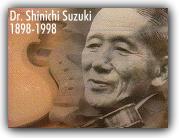 Dr. Shinichi Suzuki was born in 1898 in Japan. His father was the founder of the Suzuki Violin Company, a company that still produces violins of all sizes today.
Dr. Shinichi Suzuki was born in 1898 in Japan. His father was the founder of the Suzuki Violin Company, a company that still produces violins of all sizes today.For young Shinichi, a violin was a toy and not something to take seriously until he heard a recording of Misha Elman. He was so moved by the beauty of the sound of the violin that he decided to study it. At the time, he was already a teenager.
A friend of Suzuki’s father, pleased by his interest in the violin, invited Shinichi to join him on a business trip to Germany, where he could meet and study with great German violinists. This trip proved to be a turning point in Shinichi’s career. He ended up staying several years, studying and playing with amateur and great musicians such as Albert Einstein, and it was in Germany that he met his wife and got married.
When the Second World War was declared, he came back to Japan and started teaching in Tokyo. One day, a father brought his four-year old son to study with Shinichi. At first, he wasn’t certain whether he would accept the boy as his student. He had no idea how to teach such a young child but, in the end, he accepted the challenge. His preoccupation on how to teach this young child helped him to find the key to what would be the cornerstone of his method.
During a string quartet rehearsal, he suddenly stopped playing and exclaimed “every Japanese child can speak Japanese!” What he realized in that moment was the enormous learning potential every child possesses. If a four-year old could learn such a complex language, he could learn other skills as well if the teacher followed the natural learning process a child goes through when learning a language: observation, imitation, repetition.
After the war, Suzuki wanted to help the number of children traumatized by the war. Through music, he believed children could learn to be better human beings. He moved to Matsumoto, were he opened his school. During the late 1940s and 1950s, he started experimenting with his revolutionary teaching concept.
One of his innovations was the inclusion of disk with the method book to help young children learn their pieces better. By the early 1960s, teachers around the world were learning of this incredible school that was forming a large number of young prodigies. Groups of American and Canadian teachers travelled to Matsumoto to investigate the phenomena, and were astounded by what they witnessed. They studied with Suzuki and came back to North America determined to share and teach this amazing method.
Today, the method is taught around the world with great success. Dr. Suzuki died in 1998, just shy of his 100th birthday. His legacy remains with the thousands of young children, many whom are now adults that learned to be better human beings as a result of his teachings and methods.